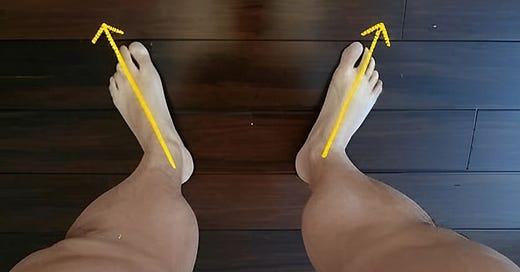Lie down. Let your body go completely still. Now look at your feet.
If one leg falls open more than the other, this is not about tight hips or flexibility.
It’s a symptom. And it starts in your brain.
This simple test has exposed something most people (and most professionals) never catch: your brain is stabilizing your spine and pelvis unevenly.
The leg that is reduced rotation could mean the brain is over-stabilizing that side. It’s not a stretch issue. It’s a postural imbalance in how your brain is organizing movement.
We see this in people who have:
One eye that doesn’t track in sync with the other
More pressure under one foot than the other
A jaw that closes unevenly left to right
Poor reflex integration or asymmetrical vestibular input
Why the Brain Controls Hip Position
If your feet collapse inward when you walk, if one foot feels flatter or more rotated than the other, or if you’re constantly rolling your ankles… it’s not just a structural problem. It’s a neurological one.
Because when your brain senses instability at the feet, it doesn’t stop there—it sends ripple effects all the way up to your hips. That’s why foot collapse often shows up with hip rotation, pelvic tilts, or one glute that just won’t “fire” no matter how many bridges you do.
Your foot isn’t just a local issue—it’s the first domino in a much bigger chain your brain uses to keep you upright. But if the first link in that chain is off, everything above it gets compromised.
Posture is not held by your muscles alone. Your brain controls posture by processing signals from your feet, jaw, and eyes to organize how you stand, move, and even lie down.
When those signals become distorted the brain starts shifting load to one side of your body to keep you upright. Over time, that shift becomes your new baseline. You feel it as tightness, pain, stiffness, or one-sided weakness.
When you lie down, the nervous system has no reason to pretend anymore. You’re not compensating to stand or move. So the pattern shows up clearly: one leg rotates less than the other. That rotation isn’t muscular. It’s neurological.
We’ve worked with thousands of clients who had this same pattern. The leg drop test is not a diagnosis it’s a mirror. It shows what your brain has been hiding in plain sight.
What Happens If You Ignore It
If your brain is offloading posture to one side, the consequences build fast:
Hip pain that never fully goes away
Back stiffness on the same side every morning
A foot that always rolls outward or inward
Constant muscle tone or knots in one glute
Sciatica, leg-length discrepancies, or low energy from standing too long
One client spent years trying to stretch their hip before realizing their imbalance started after a dental procedure. Another noticed this pattern after a foot injury, which led to knee pain and lower back strain. The brain was doing its job protecting the system. But it was working with flawed input.
The worst part? Most rehab strategies never test for this. They focus on movement, not control. And that’s why the cycle repeats.
How to Test This Right Now
You don’t need any tools. Just lie flat on your back. Breathe. Look at your legs.
Is one foot pointing out more than the other?
Does one knee feel closer to the floor?
Does one hip feel heavier?
That’s your brain revealing its compensation pattern.
And you’re not alone. Look through the comments on our Instagram post. Dancers, athletes, and people in pain for years are seeing it too. Most of them were told to stretch or "strengthen their core."
None of that works if the brain keeps prioritizing one side.
Take this image of Justin Bieber. At first glance, it looks like he’s just relaxing. But if you look closer, you’ll see exactly what we’ve been talking about: one foot flaring outward, the other pointing up, uneven tension through the hips…
This isn’t a fashion choice or a casual pose—it’s a subtle signal of how the brain is organizing movement. And it’s happening to everyday people, all the time, without them realizing it.
What you’re seeing in the image is a real before-and-after taken just minutes apart.
On the left: limited external rotation, reduced joint centration, and compensation through the knee.
On the right: improved hip mobility, deeper rotation, and a balanced resting position.
By improving the brain’s perception of the foot, we unlocked hip range of motion without touching the hip at all.
That’s the power of treating the input, not the output.
This shift wasn’t muscular — it was neurological.
What To Do Next
You have three options:
Keep stretching and foam rolling and hoping it changes
Ignore it and wait for it to show up as chronic pain
Or finally ask address the root cause of what’s causing the imbalance in the first place
The third option is the one that leads to long term relief.
We wrote a full blog called How the Brain Controls Your Foot Position (And What You Can Do About It) that that walks you through how to uncover the real reason behind your postural imbalances. It includes quick self-tests, taking under five minutes, a step-by-step guide to identify movement patterns that may contribute to asymmetry and offers exercises to help improve posture and coordination.
👉 If you’re tired of guessing and want the real protocol that resets posture from the ground up, join Posturepro+ We’ll show you the drills no one else is teaching. We’ll address what everyone else overlooks. And you’ll finally stop chasing symptoms.
💡Want a quick daily reset? Check out the 5-Minute Posture Fix for a fast, effective way to improve alignment from head to toe.







